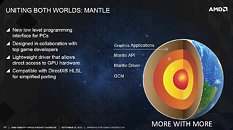- Joined
- Oct 9, 2007
- Messages
- 47,528 (7.48/day)
- Location
- Hyderabad, India
| System Name | RBMK-1000 |
|---|---|
| Processor | AMD Ryzen 7 5700G |
| Motherboard | ASUS ROG Strix B450-E Gaming |
| Cooling | DeepCool Gammax L240 V2 |
| Memory | 2x 8GB G.Skill Sniper X |
| Video Card(s) | Palit GeForce RTX 2080 SUPER GameRock |
| Storage | Western Digital Black NVMe 512GB |
| Display(s) | BenQ 1440p 60 Hz 27-inch |
| Case | Corsair Carbide 100R |
| Audio Device(s) | ASUS SupremeFX S1220A |
| Power Supply | Cooler Master MWE Gold 650W |
| Mouse | ASUS ROG Strix Impact |
| Keyboard | Gamdias Hermes E2 |
| Software | Windows 11 Pro |
Microsoft stated in its recent company blog that the Xbox One console won't support third-party 3D APIs such as OpenGL and AMD Mantle (specifically mentioning the two), and that the console will be built to take advantage of the latest DirectX 11.2 API. AMD jumped in with a quick statement on the matter, so developers don't take Microsoft the wrong way, stating that AMD Mantle was never intended to be a 3D API for consoles, but rather PCs. The API would be compatible with DirectX HLSL (shading language), to simplify porting games from DirectX over to Mantle. Says AMD;

View at TechPowerUp Main Site
What Mantle creates for the PC is a development environment that's _similar_ to the consoles, which already offer low-level APIs, close-to-metal programming, easier development and more (vs. the complicated PC environment). By creating a more console-like developer environment, Mantle: improves time to market; reduces development costs; and allows for considerably more efficient rendering, improving performance for gamers. The console connection is made because next-gen uses Radeon, so much of the programming they're doing for the consoles are already well-suited to a modern Radeon architecture on the desktop; that continuum is what allows Mantle to exist.

View at TechPowerUp Main Site











